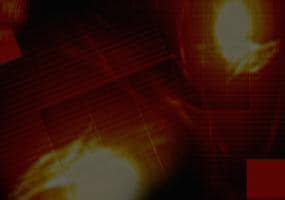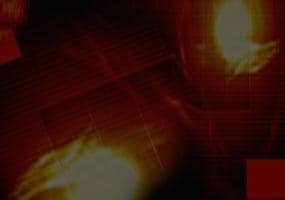At Cairo Film Fest, Beirut Terminus Documents Ups and Downs of Lebanon Through Railway
Kamal's work documents all these through the railway, and the terminus. It astonished me to see how he had used a simple rail track to take us through time.

A still from Beirut Terminus.
Romance could have had another name, railway. The railway has played Cupid on screen since time immemorial. David Lean 1945 Brief Encounter has Celia Johnson and Trevor Howard playing lovers – who meet in a railway station. Both are married and obviously there is a price to pay, consequences to face.
Much later, Mani Ratnam used a railway station and suburban trains in his Chennai-based Alaipayuthey (2000) to get Madhavan and Shalini together in a passionate love affair. They get married, but it does not signal the end of their problems. And their woes appear never to end -- like a railway track!
The railway has also been used outside sensual love – like the way Satyajit Ray showed us in his first first movie, Pather Panchali. Two young children, a sister and brother, race towards a rail track to watch a puffing engine and bogies in a scene that went on to become iconic!
But what the Lebanese director, Elie Kamal, has given us in his neat documentary, Beirut Terminus, is fascinating and truly novel. He uses a train station and the now disused lines to narrate the history of the region, Lebanon in particular, which was once part of the sprawling Ottoman Empire.
Beirut Terminus explores the notions of borders, identity and belongingness, within a perpetually troubled region of the world. Using Lebanon’s discarded railway and what’s left of its deserted infrastructure as its core scenery, the work interweaves personal and historical facts while taking a contemplative and geographical journey from the peripheral train stations of the country, towards the central station of its capital, Beirut, in an attempt to analyse , question and understand its past, present and uncertain future.
Beirut Terminus, which had its world premiere at the ongoing Cairo International Film Festival, presents a canvas of several stories. In an interview with The National, Kamal says: “In Lebanon, we don’t have a lot of parks or public spaces. But there are lots of disused railway stations and tracks. Because they still belong to the State, no one was allowed to build on them. They have been left alone, and over time have become overgrown and turned into fields. So they are safe places for children to play.” And Kamal, now 34, played on those train tracks that took off from Beirut terminus.
Sometimes, childhood experiences can become a source for later creativity, and Kamal's documentary gripped me with its vivid photography, its lucid narration and, above all, its ability to trace Lebanon's troubled history in a way that it can be compared with the history of the railway there.
As the director, cinematographer and editor, Kamal uses infrared so that the greenery could look reddish to convey the bloody times Lebanon has been through. Shooting for six years, he captured the country's history from the decline of the Ottoman Empire to present times -- which have seen the formation of what we now call Middle East. In telling visuals, we are shown colourful birds, majestic cattle and overgrown weeds all around what was once a beautiful train station. The best part is Kamal's frames are so marvellously conceptualised that they can be seen as pure art, vibrant.
Yes, Kamal also turns the picture to show us the ugly side of it all: how the disused wagons were once used to incarcerate and torture prisoners. So, what were once modes of joy – with the railway having opened in 1895 during the Ottoman regime linking Beirut to Damascus, and later to Aleppo and Tripoli – turned into sorrow and suffering.
After the war in 1948 , the railway was virtually destroyed by an uncaring Lebanese Government. The civil war which came later signed the death warrant of the railway.“The railway now looks like a skeleton, a body left to rot,” Kamal says. “It’s a corpse. And if you don’t pump blood into the veins, eventually it dies.”
In a strange way, the railway line that once united men and women became a wall, separating them. It divided East Beirut (where Christians live) from West Beirut, where most people were Muslims. And crossing from the East, where Kamal lived, to the West became problematic. The rail line stood like an impregnable barrier dividing the two faiths, and driving them away from each other.
As the film screened at Cairo, Beirut was erupting in flames bringing back memories of strife and turmoil which peppered much of Lebanon's history. Occupied by Syria for 30 years, and later by Israel for 15 , the tiny nation also saw a terrible civil war between 1975 and 1990.
Kamal's work documents all these through the railway, and the terminus. It astonished me to see how he had used a simple rail track to take us through time, mostly tragic – the photography alone colouring the screen with bright hues, the roosters and the ducks and the cows adding a bit of peace and tranquillity to what seemed like a horrific era. Will the present fire die down? Or, will it lead to another period of disquiet?
(Gautaman Bhaskaran is author, commentator and movie critic)
Get the best of News18 delivered to your inbox - subscribe to News18 Daybreak. Follow News18.com on Twitter, Instagram, Facebook, Telegram, TikTok and on YouTube, and stay in the know with what's happening in the world around you – in real time.
 Friday 26 July , 2019 Have You Watched Hilarious 'Avengers Endgame' Blooper Reel Yet?
Friday 26 July , 2019 Have You Watched Hilarious 'Avengers Endgame' Blooper Reel Yet? Thursday 18 July , 2019 Lion king Movie Review: Despite Shah Rukh-Aryan Pairing, Film Lacks Original’s Emotion
Thursday 18 July , 2019 Lion king Movie Review: Despite Shah Rukh-Aryan Pairing, Film Lacks Original’s Emotion Thursday 04 July , 2019 Spider-Man: Far From Home Review| Peter Parker Takes Us on Engrossing Vacation
Thursday 04 July , 2019 Spider-Man: Far From Home Review| Peter Parker Takes Us on Engrossing Vacation Friday 12 July , 2019 Super 30 Movie Review: Hrithik Roshan Leads Emotional Tale of Dreams And Hopes
Friday 12 July , 2019 Super 30 Movie Review: Hrithik Roshan Leads Emotional Tale of Dreams And Hopes
 Live TV
Live TV
Recommended For You
 Ariana Grande Trips on Stage During Live Performance, Fans Notice ' She Fell on Beat'
Ariana Grande Trips on Stage During Live Performance, Fans Notice ' She Fell on Beat' 31-Year-Old Man Creates Dating App Where He's The Only Guy Allowed
31-Year-Old Man Creates Dating App Where He's The Only Guy Allowed UK Labour Party Vows to Teach Colonial History in Schools and Shashi Tharoor Can't Keep Calm
UK Labour Party Vows to Teach Colonial History in Schools and Shashi Tharoor Can't Keep Calm Xiaomi Mi Note 10 With 108-Megapixel Camera to Launch Soon in India
Xiaomi Mi Note 10 With 108-Megapixel Camera to Launch Soon in India Varun Dhawan's Stunt on Coolie No 1 Sets Goes Awry, Actor Escapes Unhurt
Varun Dhawan's Stunt on Coolie No 1 Sets Goes Awry, Actor Escapes Unhurt







 4-min read
4-min read





